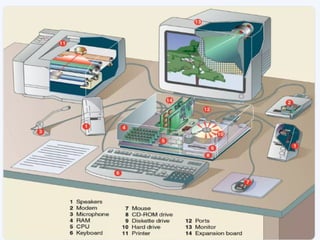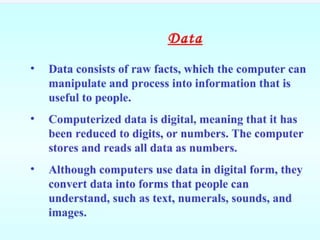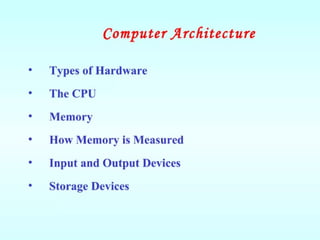1-Von Neumann architecture, programs, assembly language, high level programming languages.pptx
- 1. Problem Solving Using Computers
- 2. Syllabus
- 3. TEXTBOOKS B. W. Kernighan, D. M. Ritchie, The C Programing Language, 2nd Edition, Prentice Hall of India, 2014. B. Gottfired, Schaums Outline Series: Programming with C, 4th Edition, McGraw Hill Publication, 2018. REFERENCE BOOKS E. Balagurusamy, Programming in ANSI C, 8th Edition, McGraw Hill Publication, 2019. Y. P. Kanetkar, Let us C, 19th Edition, BPB Publication, 2022.
- 5. • Computer is designed to accept data , perform the required mathematical and logical operations at high speed and output the result.
- 6. Digital computer • A digital computer is a digital system that performs various computational tasks and represented by variables with the limited number of discrete values. • The discrete values are internally processed with limited number of discrete states. The decimal digits 0,1,2,…,9 provide 10 discrete values. • Where the first electronic digital computers developed in 1940. From here the term digital computer emerged because of many restrictions with other discrete values.
- 10. Functional Units of Computer System It is divided in two modules in general: • Hardware: A hardware of the computer system consists of all electronic components such as electronic circuits, display units, storage media (magnetic and optical (a class of data storage systems that use light to read or write data to an underlying optical media-CD, DVD)), electromechanical devices and communication facilities. • Software: It consists of the instructions and data that the computer manipulates to perform various data-processing tasks. Where sequence of instruction is called a program.
- 15. Von Neumann Architecture • Architecture defines how function works. • How Computer Runs • Von-Neumann computer architecture design was proposed in 1945. It was later known as Von-Neumann architecture. • Historically there have been 2 types of Computers: 1. Fixed Program Computers – Their function is very specific and they couldn’t be reprogrammed, e.g. Calculators. 2. Stored Program Computers – These can be programmed to carry out many different tasks, applications are stored on them, hence the name is.
- 17. Von Neumann architecture… Cont’d • Modern computers are based on a stored-program concept introduced by John Von Neumann. • In this stored-program concept, programs and data are stored in a separate storage unit called memories and are treated the same. • This novel idea meant that a computer built with this architecture would be much easier to reprogram.
- 20. Von Neumann architecture is also known as ISA (Instruction set architecture) computer and is having three basic units: Central Processing Unit (CPU), Main Memory Unit and Input/Output Unit. 1. Central Processing Unit- The central processing unit is defined as an electric circuit used for the executing the instruction of computer program. It has following major components: 1.Control Unit(CU) 2.Arithmetic and Logic Unit(ALU) 3.variety of Registers • Control Unit – A control unit (CU) handles all processor control signals. It directs all input and output flow, fetches code for instructions, and controls how data moves around the system. • Arithmetic and Logic Unit (ALU) – The arithmetic logic unit is that part of the CPU that handles all the calculations the CPU may need, e.g. Addition, Subtraction, Comparisons. It performs Logical Operations, Bit Shifting Operations, and Arithmetic operations.
- 21. Basic CPU structure, illustrating ALU
- 22. Input and Output Unit • Input: Computer accept coded information through input unit. The most common device is Keyboard. Whenever key is pressed, the corresponding letter or digit is automatically translated into its corresponding binary code and transmitted over a cable to either memory or the processor. • Output: The output unit is the counterpart of the input unit. Its function is to send processed results to the outside world. The most familiar device is a printer. Some units, such as graphical displays, provide both an input and output function.
- 23. Memory • The function of the memory unit is to store programs and data. There are two classes of storage, called as Primary and Secondary. • Primary storage is a fast memory. The memory contains large number of semiconductor storage cells, each cell capable of one bit of information. These cells are rarely used as an individual cell instead are processed in group of fixed size, called words. • To provide an easy access of any word in memory, a distinguished address is associated with each word location. Addresses are numbers that identify successive locations. The typical word lengths range from 16 to 64 bits. • Memory in which any location can be accessed in short and fixed amount of time after specifying address is called Random Access Memory (RAM).
- 24. Memory Con’d • Although primary storage is essentials and expensive. But in addition to the same cheaper memory is available as a secondary memory storage, where large amount of data and many programs may be stored. • A wide range of secondary storage are available in the form of magnetic disks, tapes and opticals disks (CD-ROMS).
- 25. 25 Memory unit The computer memory is measured in terms of bits, bytes and words. A bit is a binary digit either 0 or 1. A byte is unit of memory and is defined as sequence of 8 bits. The word can be defined as a sequence of 16/32/64 bits or 2/4/8 bytes respectively depending on the machine architecture
- 26. 26 Primary storage: RAM & ROM • RAM stands for Random Access Memory Read and write memory Information typed by the user are stored in this memory Any memory location can be accessed directly without scanning it sequentially (random access memory) During power failure the information stored in it will be erased volatile memory • ROM stands for Read Only Memory Permanent memory and non - volatile Contents in locations in ROM can not be changed Stores mainly stored program and basic input output system programs
- 27. 27 Secondary memory Main memory is volatile and limited Hence it is essential for other types of storage devices where programs and data can be stored when they are no longer being processed Installed within the computer at the factory or added later as needed
- 28. 28 Secondary memory Non-volatile memory Made up of magnetic material Stores large amount of information for long time Low speed Holds programs not currently being executed
- 29. 29 Cache memory High speed memory placed between CPU and main memory Stores data and instructions currently to be executed More costlier but less capacity than main memory Users can not access this memory
- 30. Buses – Data is transmitted from one part of a computer to another, connecting all major internal components to the CPU and memory. Types: • Data Bus: It carries data among the memory unit, the I/O devices, and the processor. • Address Bus: It carries the address of data (not the actual data) between memory and processor. • Control Bus: It carries control commands from the CPU (and status signals from other devices) in order to control and coordinate all the activities within the computer.
- 31. High level Programming Languages In computer science, a high-level programming language is a programming language with strong abstraction from the details of the computer. In contrast to low-level programming languages, it may use natural language elements, be easier to use, or may automate (or even hide entirely) significant areas of computing systems (e.g. memory management), making the process of developing a program simpler and more understandable than when using a lower-level language. The amount of abstraction defines how "high-level" a programming language is provided.
- 32. Difference between High Level and Low Level languages • Both High level language and low level language are the programming languages’s types. • The main difference between high level language and low level language is that programmers can easily understand or interpret or compile the high level language in comparison of machine. • On the other hand, Machine can easily understand the low level language in comparison of human beings. Examples of high level languages are C, C++, Java, Python, etc.
- 33. Difference between High Level and Low-level language 1. It is programmer friendly language. It is a machine friendly language. 2. High level language is less memory efficient. Low level language is high memory efficient. 3. It is easy to understand. It is tough to understand. 4. Debugging is easy. Debugging is complex comparatively. 5. It is simple to maintain. It is complex to maintain comparatively. 6. It is portable. It is non-portable. 7. It can run on any platform. It is machine-dependent. 8. It needs compiler or interpreter for translation. It needs assembler for translation. 9. It is used widely for programming. It is not commonly used now-a-days in programming. High Level Language Low-level language
- 35. Compiler • A Translator (compiler) is a program that reads a program written in one language, the source language, - and translate it into an equivalent program in another language, the target language. • In computing, a compiler is a computer program that translates computer code written in one programming language (the source language) into another language (the target language). • The name "compiler" is primarily used for programs that translate source code from a high-level programming language to a low-level programming language (e.g. assembly language , object code, or machine code) to create an executable
- 36. Assembly Language Assembly Language is a low-level programming language. It helps in understanding the programming language of machine code. • Machine code is a series of instructions that provide the necessary information to a user’s CPU to carry out a particular task (add, subtract, compare values, etc.). • In computers, there is an assembler that helps in converting the assembly code into machine code executable. • It establishes with the help of compiling high-level language source code like C and C++. • It mainly depends on the system architecture, whether it is an operating system or computer architecture to add
Editor's Notes
- #2: Imperative programming: It is a software development paradigm where functions are implicitly coded in every required step to solve a problem. In imperative programming, every operation is coded and the code itself specifies how the problem is to be solved.
- #17: The accumulator is an 8-bit arithmetic/logic unit (ALU) register. This register is used to store 8-bit data as well as arithmetic and logical operations. The accumulator stores the result of an operation
- #21: The accumulator is an 8-bit arithmetic/logic unit (ALU) register. This register is used to store 8-bit data as well as arithmetic and logical operations. The accumulator stores the result of an operation
- #25: Additional notes on memory units The computer’s memory stores data, instructions required during the processing of data, and output results. Storage may be required for a limited period of time, instantly, or, for an extended period of time. Different types of memories, each having its own unique features, are available for use in a computer. The cache memory, registers, and RAM are fast memories and store the data and instructions temporarily during the processing of data and instructions. The secondary memories like magnetic disks and optical disks have large storage capacities and store the data and instructions permanently, but are slow memory devices. The memories are organized in the computer in a manner to achieve high levels of performance at the minimum cost.
- #27: Additional notes on secondary storage devices Secondary memory on a computer is storage for data and programs not in use at the moment. In addition to punched cards and paper tape, early computers also used magnetic tape for secondary storage. Tape is cheap, either on large reels or in small cassettes, but has the disadvantage that it must be read or written sequentially from one end to the other
- #28: Input, output, and auxiliary/secondary storage devices attached to a computer are called peripherals. E.g. Magnetic tapes, magnetic disks, compact disks etc.
- #29: Additional notes on cache memory The data and instructions that are required during the processing of data are brought from the secondary storage devices and stored in the RAM. For processing, it is required that the data and instructions are accessed from the RAM and stored in the registers. The time taken to move the data between RAM and CPU registers is large. This affects the speed of processing of computer, and results in decreasing the performance of CPU. Cache memory is a very high speed memory placed in between RAM and CPU. Cache memory increases the speed of processing. Cache memory is a storage buffer that stores the data that is used more often, temporarily, and makes them available to CPU at a fast rate. During processing, CPU first checks cache for the required data. If data is not found in cache, then it looks in the RAM for data. To access the cache memory, CPU does not have to use the motherboard’s system bus for data transfer. (The data transfer speed slows to the motherboard’s capability, when data is passed through system bus. CPU can process data at a much faster rate by avoiding the system bus.) Cache memory is built into the processor, and may also be located next to it on a separate chip between the CPU and RAM. Cache built into the CPU is faster than separate cache, running at the speed of the microprocessor itself. However, separate cache is roughly twice as fast as RAM. The CPU has a built-in Level 1 (L1) cache and Level 2 (L2) cache. In addition to the built-in L1 and L2 cache, some CPUs have a separate cache chip on the motherboard. This cache on the motherboard is called Level 3 (L3) cache. Nowadays, high-end processor comes with built-in L3 cache, like in Intel core i7. The L1, L2 and L3 cache store the most recently run instructions, the next ones and the possible ones, respectively. Typically, CPUs have cache size varying from 256KB (L1), 6 MB (L2), to 12MB (L3) cache.



































